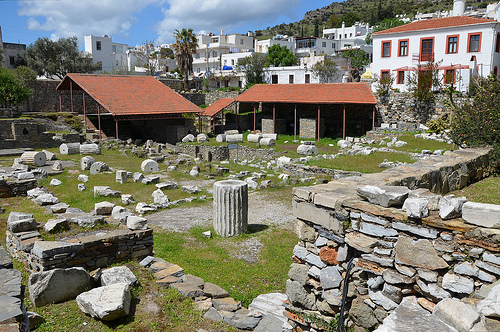The Mausoleum at Halicarnassus was once a monument of beauty, but is now the building blocks of construction.
- The Mausoleum at Halicarnassus was a tomb located in modern day Bodrum in south-west Turkey, in western Asia, which was built on a hill overlooking Halicarnassus, and made of marble and other stone.
- The ‘Mausoleum at Halicarnassus’ is also known as the ‘Tomb of Mausolus’, and the term ‘mausoleum’ that is used today in reference to grand burial sites was derived from the Greek word ‘Mausoleion’, the name that was applied to this particular site.
- The Persian ruler Artemisia II of Caria is believed to have had the Mausoleum built at Halicarnassus for the remains of her husband and brother, Mausolus, and her own remains were also entombed there.
- The Mausoleum at Halicarnassus was built around 353 BC, the year Mausolus died, by the Greek architects Satyros and Pytheos, and sculptors Timotheus, Bryaxis, Leochares and Scopas, all contributed to the design.
- The Mausoleum at Halicarnassus was famous for its aspiring beauty of architecture, decorative aspects and sculptures, including life-size (or larger) statues of lions, chariots, horses and human figures.
Mausoleum at Halicarnassus
Image courtesy of Carole Radato/Flickr
- The Mausoleum at Halicarnassus has been listed under the Seven Wonders of the Ancient World, and it was the second longest surviving construction on the list, after the Pyramid of Giza.
- The Mausoleum at Halicarnassus reached a height of around 45 metres (148 feet) and the rectangular shaped building had dimensions of roughly 30 by 40 metres (98 by 131 feet), and included 36 pillars, while the structure was topped with a pyramid-like roof.
- Between the mid 1100s and the late 1400s it is thought that the Mausoleum at Halicarnassus was devastated by a number of earthquakes.
- Crusaders destroyed much of the visible remains of the Mausoleum at Halicarnassus in the late 1400s and early 1500s, using much of the stone and debris to extend or fortify the Bodrum castle, some of which can be seen today in the structure.
- The ruins of the Mausoleum at Halicarnassus were discovered by Charles Thomas Newton, a British archaeologist, in the mid 1800s, under the direction of the British Museum, after he successfully used deduction and logic to correctly choose and determine the site location; while art pieces buried by the earthquakes are now displayed in the British Museum.
Bibliography:
The Mausoleum at Haliciarnassus, 2000, Bodrum Pages, http://www.bodrumpages.com/English/mausoleum.html
The Mausoleum at Halicarnassus, 2011, The Museum of UnNatural History, http://www.unmuseum.org/maus.htm
Mausoleum at Halicarnassus, 2015, Wikipedia, https://en.wikipedia.org/wiki/Mausoleum_at_Halicarnassus
The Mausoleum at Halicarnassus, n.d, Social Studies for Kids, http://www.socialstudiesforkids.com/articles/worldhistory/mausoleum.htm








